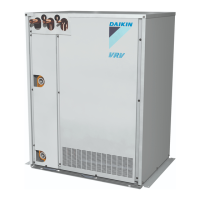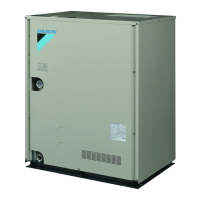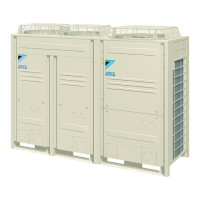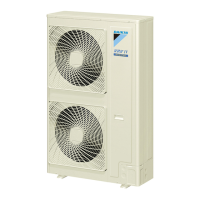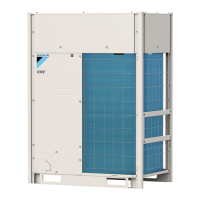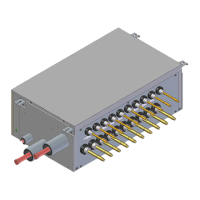5 Installation
Installation manual
25
RWEQ96~432TAYCU
VRV W T-Series water-cooled system air conditioner
4P540122-1B – 2018.11
<Vacuum drying>
Evacuate the system from the suction gas pipe, high/low pressure
gas pipe and liquid pipe stop valve service ports by using a vacuum
pump for more than 2 hours and bring the system to 500 microns or
less. After keeping the system under that condition for more than 1
hour, check if the vacuum gauge rises or not. If it rises, the system
may either contain moisture inside or have leaks.
NOTE
During the rainy season, moisture might enter the
piping. If working during a rainy season and the work
takes long enough for condensation to form inside the
pipes, take the following precautions:
After evacuating the system for 2 hours, pressurize the
system to 7 psi (50 kPa) (vacuum break) with nitrogen gas
and evacuate the system again using the vacuum pump for
1 hour to 500 microns or less (vacuum drying).
If the system cannot be evacuated to 500 microns within 2
hours, repeat the operation of vacuum break and vacuum
drying.
Then, after leaving the system in a vacuum for 1 hour,
confirm that the vacuum gauge does not rise.
5.5 To insulate the refrigerant piping
After finishing the leak test and vacuum drying, the piping must be
insulated. Take into account the following points:
▪ Makesuretoinsulatetheconnectionpipingandrefrigerantbranch
kits entirely.
▪ Alwaysinsulatethesuctiongaspipe,high/lowpressuregaspipe,
liquid pipe and pipe connections.
▪ Use heat resistant polyethylene foam which can withstand a
temperature of 158°F (70°C) for liquid piping and polyethylene
foam which can withstand a temperature of 248°F (120°C) for gas
piping.
▪ Reinforcetheinsulationontherefrigerantpipingaccordingtothe
installation environment.
Ambient
temperature
Humidity Minimum thickness
≤86°F(30°C) 75% to 80% RH 0.6 inch (15 mm)
>86°F (30°C) ≥80%RH 0.79 inch (20 mm)
Condensation might form on the surface of the insulation.
▪ Ifthere isapossibilitythatcondensationonthe stopvalve might
drip down into the indoor unit through gaps in the insulation and
piping because the outside unit is located higher than the indoor
unit, this must be prevented by sealing up the connections. See
below figure.
3×
a
b
a Insulation material
b Caulking etc.
5.6 Charging refrigerant
5.6.1 Precautions when charging refrigerant
WARNING
▪ OnlyuseR410Aasrefrigerant.Othersubstancesmay
cause explosions and accidents.
▪ R410A contains fluorinated greenhouse gases. Its
global warming potential (GWP) value is 2090. Do NOT
vent these gases into the atmosphere.
▪ When charging refrigerant, always use protective
gloves and safety glasses.
NOTE
If the power of some units is turned off, the charging
procedure cannot be finished properly.
NOTE
In case of a multiple module system, turn on the power of
all outside units.
NOTE
Be sure to turn on the power 6 hours before operation in
order to have power running to the crankcase heater and
to protect the compressor.
NOTE
If operation is performed within 12 minutes after the indoor
and outside units are turned on, the compressor will not
operate before the communication is established in a
correct way between outside unit(s) and indoor units.
NOTE
Before starting charging procedures, check if the
7-segment display indication of the outside unit A1P PCB
is as normal (see "7.2.4 To access mode 1 or 2" on
page 35). If a malfunction code is present, see
"10.2 Solving problems based on error codes" on page 45.
NOTE
Close the front panel before any refrigerant charge
operation is executed. Without the front panel attached the
unit cannot judge correctly whether it is operating properly
or not.
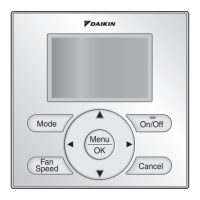
